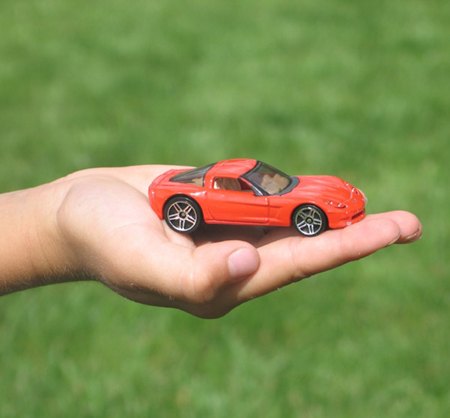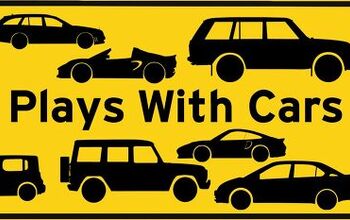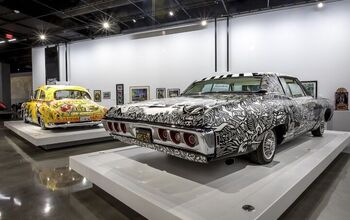Everything I Know About Cars
Driving with my windows down, a strange sound suddenly filled the cabin. "What's that noise daddy?" my six-year-old called from the backseat. "Look over buddy and you'll see." He turned quickly and blurted "Ferrari!" Although my son had taken some of his earliest steps in front of a televised image of Michael Schumacher's F1 car, before that moment, he'd never seen a Ferrari F430 in the flesh. Yet one glimpse of that scarlet red perfectly-crafted Pininfarina body, one earful of that wailing eight, and he knew he was in the presence of the prancing horse. That, my friends, is what you call branding.
Everything I ever needed to know about cars, I've known since I was five. I'm not going to argue that children possess inherent wisdom; I've listened to far too much senseless whining to buy into that. But it is true that kids look at cars from a less "burdened" perspective. They're not influenced by questions of finance, insurance, depreciation, maintenance and reliability. Although they're status conscious, their concept of "cool" has more to do with intrinsic appeal than ego gratification. By five years old, they have an instinctive understanding of which cars have "got it," and which cars don't. For example…
My two children can spot a Porsche 911 from a mile away. Despite the Carrera's constantly evolving form, no matter what the vintage (of car or kid), they know a 911 when they see one. Sure, they'd had a lot of imprinting. We've sat in Porsches at auto shows. We've stood together in awe, listening to a 911 driver crank-up that husky-sounding flat-six. Someday, if I raise them right, they'll be able to make the kind of 911 model and year distinctions that pistonheads use as a kind of secret handshake. But for now, my four and six-year-old see a Carrera and race to shout "911." Inevitably, the one who doesn't see the car first cries.
Look at children's car drawings. There's a startling similarity of form: large wheels, little overhang, sleek beltline and chopped greenhouse. These are the elements that comprise our earliest understanding of what makes a car desirable. Somewhere in our early-adulthood, we figure it's OK to sacrifice the basics– so long as we get the business case right. In other words, we give up the purity of our emotional connection because, well, we have to. We love our car but covet something else. Something a lot more expensive and a lot less responsible.
Why do mainstream motors look like they were based on a survey of a large group of randomly selected people from a broad cultural and economic demographic– other than the fact that they are? Modern manufacturers seem to take all their prospective customers' rational answers, blend them into a vehicle soup, and then "hone" the design until it has been assigned all the brand-defining character lines and sun catchers that the sheet metal can withstand. If you want to see the ultimate expression of this "a camel is a racehorse designed by a committee" aesthetic, check out the Pontiac Aztek.
Meanwhile, every time I drive by our local Hummer dealer, my kids fight for the best view. "Look, there's a new orange one" says my son. "I want that one,' my daughter cries, referring to a dubbed-out, flippity-flop purple-turquoise example. How do they know that the Hummer is the ultimate expression of machismo this side of Jurgen Von Strangle? They just do. In fact, by the time a nascent pistonhead reaches five, he or she can distinguish the authentic cars from the intenders. They spend hours lining-up Matchbox, caring for the good ones, giving them names and identities, racing them around a little orange track, sorting the miniature wheat from the palm-sized chaff. There's your ideal focus group.
Large organizations analyze, scrutinize and complicate their cars to death. They pay lip service to the importance of "car guys" and hire "car czars" to counter the "bean counters." When push comes to shove, originality and authenticity gets pushed and shoved straight out the door. An automaker can offer a car with the best gas mileage, the longest warranty, the fastest zero to sixty time, the most distinguished badge and the curviest body. But they can't simply dip into the global parts bin and create something that touches that primal place that started in childhood, and still exists within all of us.
Last week, my son and I encountered a swooping 1967 Chevrolet Corvette in glitter-flake blue. "Whoa!" my son whispered, as his hand started stroking the curvy hips of the old-school exotic. "Don't touch it," I replied. "It's not ours." But in a way, it was.
More by Bryan Russel
Latest Car Reviews
Read moreLatest Product Reviews
Read moreRecent Comments
- V8fairy Not scared, but I would be reluctant to put my trust in it. The technology is just not quite there yet
- V8fairy Headlights that switch on/off with the ignition - similar to the requirement that Sweden has- lights must run any time the car is on.Definitely knobs and buttons, touchscreens should only be for navigation and phone mirroring and configuration of non essential items like stereo balance/ fade etc>Bagpipes for following too close.A following distance warning system - I'd be happy to see made mandatory. And bagpipes would be a good choice for this, so hard to put up with!ABS probably should be a mandatory requirementI personally would like to have blind spot monitoring, although should absolutely NOT be mandatory. Is there a blind spot monitoring kit that could be rerofitted to a 1980 Cadillac?
- IBx1 A manual transmission
- Bd2 All these inane posts (often referencing Hyundai, Kia) the past week are by "Anal" who has been using my handle, so just ignore them...
- 3-On-The-Tree I was disappointed that when I bought my 2002 Suzuki GSX1300R that the Europeans put a mandatory speed limiter on it from 197mph down to 186mph for the 2002 year U.S models.


































Comments
Join the conversation